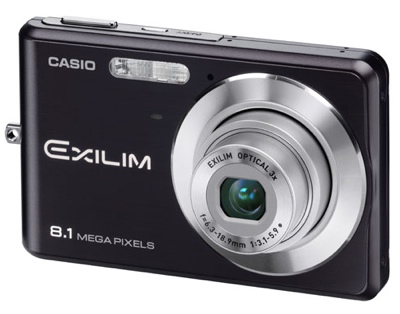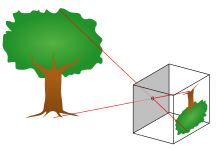Process
We could all use any sort of box to create our camera, (anything that has a tight-fitting top) so I bought in a Pringle's tube to use as my Pinhole Camera. To start off with I marked a square in the centre of the tube (which would be used to put the lens in place) and cut it out myself with a pen knife. To make the tube light-tight, I painted the inside with dull black paint to prevent light reflections. While I waited for it to dry, I cut and straightened out some foil which is used as a lens like on a real camera which captures the light from the subject and brings it to a focus.
I then covered the hole with the foil on the outside of the tube and taped around the foil with Gaffa tape. As the Pringle's tube lid is see through, which would have given in too much light, I had to get some black paper and put it over the top and put an elastic band around it to keep it in place.
I then made a tiny little hole in the centre of the foil which was the aperture (which light travels through) with a pin which is to catch the actual image. Then finally with another bit of black paper I made a flap (which is called the Shutter which is a device that allows light to pass for a determined period of time) over the lens, to keep the light out.
Before we went anywhere, we measured the f-stops which were the Distance from the pinhole to the paper, divided by the Diameter of the pinhole (mm). This would then tell us how long to expose the tube in and outside.
Once my tube was all complete I entered the Dark Room with Zoe and listened to Tim go on about Health & Safety and how long to leave the images in the chemicals etc.
After that, we all got given some Photographic Paper (which would be the film in a real camera). I placed it in the tube making sure the shiny side was facing the lens. Then me and Zoe went down to the Atrium and placed our tubes on one of the comfy seats and left our tubes to expose for 8 Minutes. We timed this by using Zoe’s stopwatch on her phone.
 After the 8 Minutes I went back upstairs into the Dark Room and took the Photographic Paper out of the tube and put them in the three chemicals. The first chemical was from 20 Seconds to a minute, then some water which we would only have to leave for about 30 seconds, and then in another chemical for at least 30 Seconds. They then developed into negative images.
After the 8 Minutes I went back upstairs into the Dark Room and took the Photographic Paper out of the tube and put them in the three chemicals. The first chemical was from 20 Seconds to a minute, then some water which we would only have to leave for about 30 seconds, and then in another chemical for at least 30 Seconds. They then developed into negative images. After that, I put in another bit of Photographic Paper and went down to the car park and placed my tube on the floor in front of a car. It was exposed for 75 Seconds, but when we went upstairs to develop the images, it came out all black, which meant that it was exposed too long with that amount of light.
When making that mistake me put another bit of Photographic Paper in the tube, went back down to the car park and exposed it for 45 Seconds, which then did come out with much better results.
Purpose
The pinhole camera is a manual, lensless, often handmade camera. It literally takes long-exposure photos through a pinhole that projects an inverted image into a darkened box. Pinhole cameras serve many purposes, from purely artistic to the scientific. When learning about photography process, making and using a pinhole camera gives us a close-up look at how pictures are made simply using light. Its fun and experimentation and helps to provide an understanding of how all different kinds of cameras work. Evaluation
I did some research on other people's Pinhole Camera's process etc. When I visited www.pinholephotography.org/ I found out that a man in Italy did a much different exposure than me. He left his camera for six months out in the rain, wind and hail in Bristol. All these different artists did much more pictures and they were proper clear. Obviously I didn't have six months so I couldn't get a clear, clear image but from what I did for 8 Minutes I think they came out really good. If I was to go over everything I would of definitely chose a different box because the Pringles tube was difficult to paint inside and think that using a shoe box would have been so much easier and given a much better image. A couple of things went wrong, for example, the location outside the college. When I left the tube for 75seconds there was too much light and was left for a long time with that amount of light so that’s one thing that went wrong. Except for the painting and outside everything else went okay. I think that the Atrium was a good location to capture because it came out really good and clear and there was no wind and nobody walked past it so it captured a good image. But one thing that was annoying was the part where the paint would dry inside so I and Zoe had to keep going in the toilets to hand dry it.
From pinhole to digital camera
Early Observations and Experiments
The basic principles of the pinhole are commented on in Chinese texts from the fifth century BC. Chinese writers had discovered by experiments that light travels in straight lines.
Early Observations and Experiments
The basic principles of the pinhole are commented on in Chinese texts from the fifth century BC. Chinese writers had discovered by experiments that light travels in straight lines.
The philosopher Mo Ti, was the first – to our knowledge – to record the formation of an inverted image with a pinhole or screen. Then by the late 1880s the Impressionist movement in painting exerted a certain influence on photography. Different schools or tendencies developed in photography. The "old school" believed in sharp focus and good lenses; the "new school", tried to achieve the atmospheric qualities of paintings. Pinhole photography became popular in the 1890s. Commercial pinhole cameras were sold in Europe, the United States and in Japan. 4000 pinhole cameras were sold in London alone in 1892. The cameras seem to have had the same status as disposable cameras today – none of them have been preserved in camera collections. Some years earlier, an American company had actually invented a disposable pinhole camera. Mass production of cameras and "new realism" in the 20th century soon left little space for pinhole photography. By the 1930s the technique was hardly remembered, or only used in teaching. Some man of what was later to become the Rochester Institute of Technology, was possibly the first college professor to stress the educational value of the pinhole technique. He also designed the Kodak Pinhole Camera around 1940. Now in 21st Century we use digital cameras. But if it wasn't for the invention of Pinhole Camera's then these digital camera's wouldn't of come to mind (Digital cameras were developed in the last quarter of the 20th century, from predecessors including video camera tubes).


